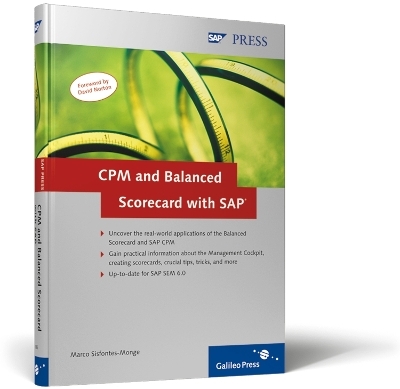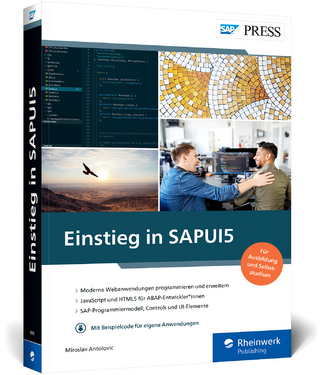
CPM and Balanced Scorecard with SAP
SAP Press (Verlag)
978-1-59229-085-7 (ISBN)
- Titel ist leider vergriffen;
keine Neuauflage - Artikel merken
Organizations looking to implement SAP Corporate Performance Monitor (CPM), using the Balanced Scorecard approach, will benefit greatly from this practical guide. This book clearly explains the Balanced Scorecard and its relationship with SAP CPM, and gives readers a thorough knowledge of the central concepts of both. This comprehensive reference includes practical information on utilizing the management cockpit, creating scorecards in SAP CPM, tips, tricks and much more.
Marco Sisfontes-Monge has worked in the following sectors: Automotive, Logistics, Software, Gas & Electric, Discrete and Process Manufacturing, Retailing, and Financial Services. His clients include John Deere, Matsushita, Schneider Electric, Sara Lee, Conair, Pacific Gas & Electric, New York Power Authority, Hyperion, and Peoplesoft. He is the author of the SAP PRESS book, CPM and Balanced Scorecard with SAP.
Foreword ... 13 Acknowledgments ... 15 1. Introduction and Overview ... 18 ... 1.1 How this Book is Organized ... 18 ... 1.2 Getting the Most out of this Book ... 18 ... 1.3 Summary ... 19 2. Translating Strategy into Action: The Balanced Scorecard ... 21 ... 2.1 Overview ... 21 ... 2.2 History of the Balanced Scorecard ... 21 ... 2.3 The Balanced Scorecard: Conceptual Foundations ... 23 ... 2.4 The Balanced Scorecard: Components and Structure ... 24 ... 2.5 The Need for a Balanced Scorecard Process ... 26 ... 2.6 SAP BW: Conceptual Foundations ... 27 ... 2.7 Building SAP BW InfoCube Architecture ... 29 ... 2.8 SAP CPM: Conceptual Foundations ... 33 ... 2.9 Summary ... 35 3. Introduction to SAP CPM ... 37 ... 3.1 The Balanced Scorecard Model using SAP CPM ...38 ... 3.2 SAP CPM Components ... 41 ... 3.3 Integration of CPM with other SAP components ... 72 ... 3.4 Drilldown Applications in the Management Cockpit ... 74 ... 3.5 Summary ... 77 4. The Measure Builder ... 79 ... 4.1 Overview of Measure Builder ... 79 ... 4.2 The Measure Builder Framework ... 81 ... 4.3 Components of the Measure Builder ... 84 ... 4.4 Creating Your First Measure ... 87 ... 4.5 The Measure Configuration ... 89 ... 4.6 Assigning Measures to a Scorecard ... 105 ... 4.7 Risk Catalogs and the Measure Builder ... 110 ... 4.8 The SAP Measure Catalog ... 111 ... 4.9 Summary ... 115 5. Creating Your First Scorecard ... 117 ... 5.1 Introduction ... 117 ... 5.2 Creating Your First Scorecard ... 118 ... 5.3 Adding Data to Your Scorecard ... 140 ... 5.4 Lower-Level and Derived Scorecards ... 148 ... 5.5 Summary ... 152 6. The Management Cockpit ... 153 ... 6.1 What is the Management Cockpit? ... 153 ... 6.2 Structure of a Cockpit ... 155 ... 6.3 Creating Your First Management Cockpit ... 158 ... 6.4 The SAP Transport Process ... 178 ... 6.5 Linking Measures to Specific Frame Types ... 180 ... 6.6 The Management Cockpit Monitor ... 214 ... 6.7 The Cockpit Presentation Tool ... 216 ... 6.8 Summary ... 224 7. The Risk Management Module ... 227 ... 7.1 Risk Management: General Overview ... 227 ... 7.2 The Risk Management Process in SAP CPM ... 231 ... 7.3 Components of the Risk Builder ... 233 ... 7.4 Adding Risk to Your Scorecard ... 235 ... 7.5 Risk Management and the Risk Monitor ... 247 ... 7.6 Adding Risk to your Balanced Scorecards ... 250 ... 7.7 Risk Management Options in the Balanced Scorecard ... 257 ... 7.8 Summary ... 259 8. Monitoring the KPIs: The Strategy Map and the Value Driver Tree ... 261 ... 8.1 General Overview ... 261 ... 8.2 The Strategy Map ... 263 ... 8.3 The Value Driver Tree ... 274 ... 8.4 Linking Your VDTs to Your Scorecard Applications ... 290 ... 8.5 Summary ... 291 9. SAP CPM Tips and Tricks ... 293 ... 9.1 Overview ... 293 ... 9.2 Creating CPM Variables ... 293 ... 9.3 Using CPM Variables in Cockpits ... 296 ... 9.4 Using CPM Variables in Scorecards ... 309 ... 9.5 Working and Configuring Trend Indicators ... 314 ... 9.6 Creating Formulas and Score Assignment Tables ... 318 ... 9.7 Status and Score ... 323 ... 9.8 Using the Graphic Editor Wizard ... 327 ... 9.9 Creating Substitutes ... 336 ... 9.10 Periodization and Time Variables ... 337 ... 9.11 Using the Balanced Scorecard Launchpad ... 351 ... 9.12 The Web Application Server (WAS) and Cockpits ... 353 ... 9.13 Transporting Scorecards to Other Systems ... 355 ... 9.14 Scaling Factors ... 359 ... 9.15 Summary ... 361 10. Corporate Governance ... 10.1 The Sarbanes-Oxley Act: A Brief Overview ... 363 ... 10.2 Corporate Governance and Sarbanes-Oxley ... 364 ... 10.3 The COSO Framework of Internal Controls ... 366 ... 10.4 The SAP Sarbanes-Oxley Process ... 368 ... 10.5 Summary ... 370 11. Concluding Remarks ... 371 ... 11.1 Final Tips ... 373 ... 11.2 Summary ... 376 Appendix ...377 ... A Glossary ... 377 ... B Bibliography ... 379 ... C Author ... 381 ... Index ... 383
| Erscheint lt. Verlag | 1.1.2007 |
|---|---|
| Verlagsort | Maryland |
| Sprache | englisch |
| Maße | 180 x 230 mm |
| Einbandart | gebunden |
| Themenwelt | Informatik ► Weitere Themen ► SAP |
| Wirtschaft ► Betriebswirtschaft / Management | |
| ISBN-10 | 1-59229-085-X / 159229085X |
| ISBN-13 | 978-1-59229-085-7 / 9781592290857 |
| Zustand | Neuware |
| Informationen gemäß Produktsicherheitsverordnung (GPSR) | |
| Haben Sie eine Frage zum Produkt? |
aus dem Bereich


